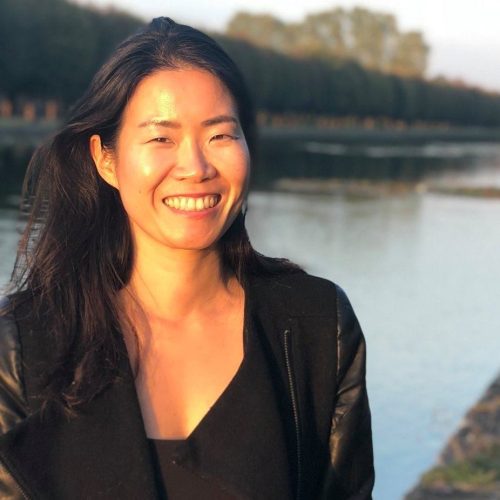Articles
What we’re contemplating, doing, and reading.
From Corporate Burn-Out To Compassionate Living

On the surface my life was going “as planned,” and yet I felt hollow inside.
In 2017, I had an amazing career, having progressed from various roles at Apple and Microsoft to a partnership team at Facebook (now Meta Platforms). I was progressing as a leader and working with various partners globally on many high impact projects. I was feeling safe financially and able to provide for my family back in Korea, too.
Additionally, I traveled around the world for fun and for work, meeting many interesting people. Everything looked good, right?
Except I felt very empty.
The work culture in the tech industry was always highly competitive and fast-paced, regardless of which company I worked at. I was able to build great professional skill sets from being in these types of environments for 13 years, but I was also suffering immensely internally.
I thought I was simply experiencing stress and hoped I could recover after a relaxing vacation in a tranquil place. Yet the same feeling of emptiness came back after the trip was over.
Starting My Healing Journey

I started meditating more and practiced more yoga—even getting certified as a yoga teacher. I felt happy in my meditation and yoga practice momentarily, but my state of mind shifted back to the anxious self-critical mode when I went to work. The emptiness and hollowness I experienced was from the chasm between the external work culture that I faced every day and my desperate aspiration to feel good internally.
I felt like I was wearing a certain mask at my job to “fit” into a certain model that the work culture required to be deemed as “successful,” although that mask wasn’t for me. Furthermore, I wasn’t sure who I was becoming anymore. It was painful. As I started sharing my struggle with a few people I trusted at work, to my surprise, they all shared a somewhat similar sentiment.
I realized, “Oh, it’s not just me—there are other people who feel the same way I do and they are suffering like I am.” I wanted to do something about it. How could we feel more wholesome at workplaces? That was the question I was living with.
Discovering Compassion Cultivation™ Training (CCT™)
My main coping mechanism in difficult situations has always been “learning.” I read books, take classes, or meet people from whom I could learn about the challenges that I find meaningful. So I started taking many courses in 2017, and one of the trainings that stood out to me was the Compassion Cultivation™ Training (“CCT™”)—initially developed at Stanford University by Thupten Jinpa, Ph.D. with contributions from Compassion Institute’s Founding Faculty.
The first time I learned about CCT™ was when I read Into the Magic Shop by Dr. James Doty. The way Dr. Doty was able to overcome the adverse childhood experiences of his upbringing through meditation was incredible and inspiring. What was more inspiring to me was how he integrated his experience as a meditation practitioner into his profession as a neurosurgeon.
As a neurosurgeon at Stanford Hospital, Dr. Doty was definitely an expert in the domain of brain mechanics. On top of that, he could overlay his own felt experiences in the power of mindfulness practices—and his personal journey was a testament itself for the lasting change that mindfulness practices could bring. To research and raise the awareness of this understanding further, he founded the Center for Compassion and Altruism Research and Education at Stanford University.
Fascinated by his story and intention with compassion, I immediately signed up for CCT™ in 2017. And every Saturday morning for eight weeks, I drove from my apartment in San Francisco to Stanford Medical School in Palo Alto to join my 20 classmates in learning what it meant to be compassionate to myself and others.
Learning to 'Be' With My Own Suffering

I discovered so much in the CCT™ class, but the most transformative learning moment was when I felt what it meant to be with my own suffering instead of trying to fix it.
Sitting with my painful experiences from the past, I could feel everything that came with it—the details of the experience, the emotions, and the thoughts behind the emotions. At first it was so challenging, but eventually all of the swirling, difficult emotions started to settle on the ground, like in a snow globe. I could finally see what was at the bottom of my suffering.
There wasn’t much, which was both surprising and anticlimactic. It was just my own idea about myself and my expectations on how things should be. When I asked myself the question, “Is there any truth behind these ideas and expectations?,” they evaporated. No, they were just stories created in my mind, not truth.
Understanding What Makes a Good Teacher
While the CCT™ content was great, I couldn’t help but think that it was my CCT™ teacher, Robert Cusick, who contributed the most to creating this moment of impact on me.
Robert lived as an ordained monk for a while before he started teaching CCT™ in the secular world. Although he wasn’t practicing in monk’s robe anymore, in a way, he was still doing the same thing in the CCT™ class with us. I admired his embodiment of compassion.
Based on his experience as a monk, he was a great guide during the contemplative practices we were doing in the classroom. Yet what I appreciated most about him was his way of integrating and adapting his understanding of compassion into our everyday lives. He didn’t put himself up on the pedestal as a “teacher,” but was able to meet us where each of us were, on the same level.
Without enforcing, “this is what compassion should be,” Robert made us rediscover the compassion that was inside of all of us. Like Dr. Doty, he understood the lasting impact of compassion from his own experiences and wanted to share with everyone who was interested in it. Also like Dr. Doty, he was integrating his own background while adapting his teaching skillfully in the class.
Without enforcing, “this is what compassion should be,” Robert made us rediscover the compassion that was inside of all of us. Like Dr. Doty, he understood the lasting impact of compassion from his own experiences and wanted to share with everyone who was interested in it. Also like Dr. Doty, he was integrating his own background while adapting his teaching skillfully in the class.
Taking the Leap into CCT™ Teacher Training
As I finished the CCT™ program, I started thinking about what I could do with my training. Obviously, I would continue to practice compassion personally, but I was eager to share it with more people at my workplace in the tech industry—where the word compassion sounds like a foreign language. This aspiration led me to apply for the CCT™ Teacher Training with the Compassion Institute (CI) in 2018. With great teachers and fellow trainees, I went through an 11-months training journey, including teaching a practicum class at Facebook, my workplace.
Frankly, it wasn’t easy to do the teacher training while working full-time at my demanding job. Moreover, I was so eager to make a meaningful change in the work culture with emotional intelligence and compassion that I signed up for another teacher training (Search Inside Yourself Teacher Training) at the same time—and, in hindsight, it was too ambitious. (Note: For extreme clarity, I don’t recommend anyone to do more than one teacher training on top of their full-time job).
Yet what made it all worthwhile was the deep learning from the teachers, the community of fellow trainees, and all the practices.
Lasting Impacts of CCT™ Teacher Training
As I think about the lasting impact of the CCT™ Teacher Training, I come back to two main points: 1) The embodiment of mindful and compassionate presence in all aspects of life and 2) the power of community of compassionate relationships at work places.
1. Embodiment of Mindful & Compassionate Presence

Compared to the other teacher training, what I found so profoundly different and impactful with CCT™ Teacher Training was the embodiment of mindful and compassionate presence in and out of the classroom. It’s hard to describe what it means to embody mindful and compassionate presence in words, so it’s even harder to teach. Yet the facilitators of the teacher training and the Compassion Institute staff showed the embodiment in the way they taught, spoke, listened, responded, looked, and held the classroom—either virtually or in person.
I knew it was important, but I didn’t fully appreciate this emphasis on the embodiment in the beginning. Only after I started teaching, could I see the impact of embodiment in my own way. For example, during the CCT™ Teacher Training, we were asked to attune empathically with participants, the entire class, and ourselves as instructors.
During the CCT™ classes I taught, there were many moments that I stumbled as an instructor. There were questions from participants I didn’t know how to answer. Instead of letting self-doubt take over in that moment, I could quickly attune to myself and notice the fear. Once I noticed the fear in that brief moment, I could acknowledge that I couldn’t know everything in the world. Then I could respond to the participant with honesty and genuine care, without pounding myself with harsh self-criticism.
After doing some contemplation and research on that question, I would follow up in the next class or invite the entire class to share their thoughts, too. In my own CCT™ program, I learned how important this was in creating a safe space for participants; as I was able to embody a gentle attitude toward myself, participants in the class were able to learn how to be gentle with themselves.
This embodiment of mindful and compassionate presence also created a very meaningful impact on me as a leader at work. I started paying more attention to how I listened to others in all forms of communication. When I noticed that I was having certain judgmental thoughts about someone in a meeting, I was able to observe my thoughts without acting on them. That way, I was able to act with discernment and make better decisions about work. I started getting better feedback from my managers and my team. And it showed in my performance evaluation—I was promoted twice in two years!
Although that wasn’t what I intended with the CCT™ Teacher Training, I was becoming a better leader as a result of practice in embodiment. Yet the best part was something else, which I found most surprising: I was able to perform without getting stressed out. The embodiment of mindful and compassionate presence helped me to take care of myself internally, and that took care of my stress reactions.
2. A Community of Compassionate Relationship at Workplaces

In the world of many books and support materials on various kinds of contemplative practices, apps, and neuroscience research, it was getting easier to learn what mindfulness was or what compassion was intellectually. Yet there was still an insatiable demand for “learning” among the Mindfulness Club at Facebook where I was a co-lead. As I got certified by the Compassion Institute to teach CCT™ in 2019, I started offering the classes for the Mindfulness Club members at Facebook.
At first, I thought I could help the colleagues most by correcting their misunderstandings about compassion. But what I discovered as I led more CCT™ classes was students were less interested in intellectual learning than in the sense of comfort they experienced by learning how to relate to each other compassionately.
As I finished teaching the eighth week of CCT™ with one cohort, a tearful participant said that she never expected that she could be herself at work—sharing her own struggle juggling many roles in her life as a mother, wife, daughter, manager, and employee. Others echoed that they were feeling sad to think that it was the last class. Some were suggesting to continue to meet even after the class was over.
This response wasn’t limited to one cohort but repeated over and over. Every time I saw such responses, my heart ached because I could feel the suffering of so many people at workplaces who desperately want to be seen and heard as a whole being—not just as an employee. At the same time, I felt hopeful because I was learning that it was possible to create a space to help people see each other as whole beings. It was possible to create a community of compassionate relationships at workplaces.
This was an important lesson for me, because it suggested that the path to change the workplace culture wasn’t limited to the top-down approach from the leadership. As I started thinking about my own struggle in the work culture and how to change it to make me feel more wholesome, I thought conventionally that the leadership and management held the key to creating change.
However, after engaging with 3,000 people about mindfulness and compassion—while leading Mindfulness Club at Facebook for 3 years—I learned that the community in which participants relate to each other with mindfulness and compassion was equally (or more) important in order to create a wholesome workplace culture.
The CCT Teacher Journey as a Practice
I hope I could continue to practice embodiment in any life circumstances, and I would like to help organizations to unlock the power of community inside based on the compassionate relationships. But ironically, when it comes to CCT™, I don’t see myself as a teacher anymore even though I am a certified teacher. Rather, as this journey continues, I more clearly see myself as a practitioner of compassion.
My journey as a CCT™ teacher is a lifelong practice for myself as a human. Compassion forms a natural bridge between self-knowledge and self-acceptance. By offering CCT™, I could learn more about myself and practice what it means to be in this world in each moment as is. There is no end-goal for this practice. I am so grateful for the CCT™ Teacher Training that created great opportunities to continue to practice compassion.
Click here to help others embody compassion in their lives.
Click here to read more compassion blogs and stories.

